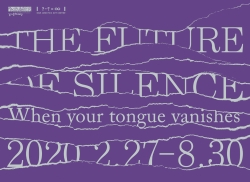
The exhibition ‘‘The Future of Silence: when your tongue vanishes’’ held in the Nam June Paik Art Center (NJPAC), attempts to shine a light on the issues with the minority languages.
The exhibition, which was held from Feb. 27 to Aug. 30, presents and showcases the existence of different beings who speak vanishing languages.
The concept stems from a novel of the same title by Kim Aeran where the extinction of language appears to be the death of a person.
Kim Yoonseo, the main curator in charge of the exhibition, gave a detailed explanation of the theme.
“As NJPAC is the only public media art museum in Korea, we felt responsible to investigate language as an origin of media,” Kim said. “The message of the novel inspired us to regard language as media since language exists only when more than one people speak it.”
To deliver the message of the exhibition, Kim mentioned the anxiety and dismissal over the world towards different and unfamiliar beings.
“It is questionable whether those anxieties would disappear if all the difference vanishes” Kim said. “Therefore, the exhibition suggests that we should understand and embrace differences, specifically those who speak diverse languages with their unique expressions. In this regard of pursuing diversity, we invited the artists from different countries, with different genders, ages, and awareness to the exhibition.”
Kim Woojin, who earned a doctorate in painting at College of Art & Design in Ewha, displayed two video works in the exhibition.
Her four-channel HD video project named ‘‘The Perfect Harmony’’ shows 10 Haenyeos on a screen singing their work song. Haenyeo are widely known Korean female freedivers on Jeju Island.

In Kim’s display, each Haenyeo disappears from the screen one by one along with the sound of singing, representing the slowly disappearing unique language in Jeju.
“In 2016, I researched minority languages in Taiwan as a part of my residency program,” Kim said. “When colleagues asked me about languages in Korea, I used to answer that Korea has only one language, Korean. But thinking of Jeju, I realized that I was also part of a social mechanism that left Jeju language out of Korean language.”
Concerned with the issue, Kim found that the Jeju language and a lifestyle of Haenyeo are linked in that both existences are in danger of extinction.
“I remember one of the Haenyeos said that there were no more of them lately,” Kim said. “Her words made me realize that pursuit of newness might dim what really matters to us and what we should preserve.”
As Kim’s video ‘‘The Perfect Harmony’’ ends, it is followed by her project ‘‘Korean Dictation Test.’’
One side of the screen shows a person using standard Korean who tries to dictate Jeju language. On the other is an hourglass, showing different hands scooping the sand off from the upper part of the hourglass.
“The person who dictates Korean represents those who believe there is only one language in Korea,” Kim said.
Kim refers to this as what she calls “social frames” where it is represents the tacit social agreements and mechanisms in Korea that there is only one central language.
“When people get used to the social mechanisms, they let themselves work in another social frame. This process makes minority languages vanish,” she commented. This was explicitly shown in her project by the scooping of the sand from the top, resulting in the lower part of the hour glass receiving less and less sand and eventually vanishing.
“I hope that individuals can question themselves on unquestionable acceptances of the idea of only one language being in Korea,” Kim said.

